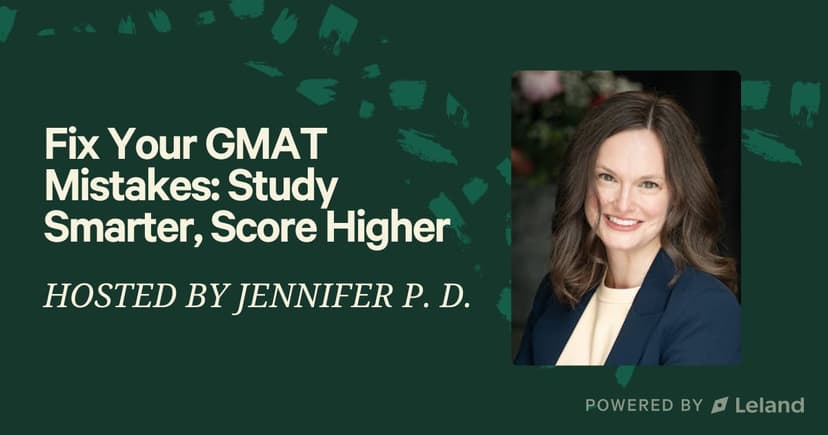
Join a free event
Learn from top coaches and industry experts in live, interactive sessions you can join for free.
Table of Contents
The GMAT exam is a key step for anyone planning to apply to business school. As of 2023, the exam is now known as the GMAT Focus Edition, and the structure has changed. Understanding the GMAT sections is the first step in building a solid study plan. In this guide, we’ll break down each part of the test, explain what’s tested, and walk you through preparation strategies that help you focus your efforts.
GMAT Focus Edition vs. the Classic GMAT
In 2023, the Graduate Management Admission Council (GMAC) introduced the GMAT Focus Edition to modernize the exam and reflect skills that business schools value today, particularly the ability to reason, analyze, and interpret data. The changes affect both the structure and content of the test, making it shorter, more targeted, and more flexible for test takers. At the end of each section, test takers can review and change up to three answer choices. This is done through the dedicated edit screen, which allows users to review and modify their answers before final submission.
What Changed in the GMAT Focus Edition?
- The Analytical Writing Assessment (AWA) and Integrated Reasoning sections were removed: These sections were part of the Classic GMAT but are no longer included in the Focus Edition. The AWA tested essay writing, while Integrated Reasoning involved interpreting charts and graphs.
- GMAT Data Insights section: The GMAT Data Insights section focuses on analyzing and interpreting data from multiple sources, including graphs, tables, and text passages. It blends quantitative and verbal logic, measuring your ability to make data-driven decisions in a modern business context.
- The exam is shorter: The total test time dropped from approximately 3.5 hours to 2 hours and 15 minutes, reducing test fatigue and making the exam more efficient.
- Test takers can now choose the section order: The Classic GMAT had a fixed order. In the Focus Edition, you can start with any of the three sections, Quantitative Reasoning, Verbal Reasoning, or Data Insights, and complete the others in the order you prefer. There are six possible section combinations.
- Scoring was updated: The total GMAT score now ranges from 205 to 805, with each section scored between 60 and 90 in 10-point increments. All three sections are equally weighted in the final composite score.
GMAT Format Comparison Table
| Feature | Classic GMAT | GMAT Focus Edition |
|---|---|---|
| Sections | 4 (Quant, Verbal, Integrated Reasoning, AWA) | 3 (Quantitative Reasoning, Verbal Reasoning, Data Insights) |
| Total Time | ~3 hours 30 minutes | 2 hours 15 minutes |
| Scoring Scale | 200–800 (only Quant & Verbal used) | 205–805 (all three sections used) |
| Section Order | Fixed | Customizable (6 order combinations) |
| Writing Component | AWA included | Not included (separate optional BWA) |
| Data Analysis Section | Integrated Reasoning | Data Insights |
Why These Changes Matter
The GMAT Focus Edition was designed to make the exam more aligned with the analytical tasks expected in modern business schools and post-MBA careers. Instead of testing writing or grammar correction rules, the Focus Edition prioritizes:
- Your ability to solve complex problems using logic and math
- Your ability to evaluate arguments and comprehend written material
- Your ability to analyze and interpret data from tables, charts, and multiple sources
Note: The Data Insights section in particular represents this shift. It includes formats like table analysis, graphics interpretation, multi-source reasoning, two-part analysis, and data sufficiency questions, all of which are designed to measure your ability to make informed decisions using structured data. The more flexible format also benefits GMAT test takers who want to start with their strongest section or manage fatigue strategically.
Overview of GMAT Sections (Focus Edition)
The GMAT Focus Edition includes three sections, each designed to test a different set of reasoning skills that business schools value. Each section lasts 45 minutes and contributes equally to your total GMAT score. These sections are:
- Quantitative Reasoning – Measures your ability to solve complex problems using math and logic. The GMAT Quant Section is a core part of the exam that tests mathematical reasoning, problem-solving skills, and fundamental math concepts.
- Verbal Reasoning – Measures your ability to comprehend written material and evaluate arguments. The GMAT Verbal Reasoning Section focuses on reading comprehension, critical reasoning, and analysis of passages, with a specific structure and question types designed to assess these skills.
- Data Insights – Measures your ability to interpret data and draw conclusions using information from multiple sources.
The quant section, which is the quantitative portion of the GMAT, has a specific structure and tests your understanding of fundamental math principles, making it essential to have a solid math foundation.
GMAT Focus Section Summary Table
| Section | Number of Questions | Time Limit | What It Measures |
|---|---|---|---|
| Quantitative Reasoning | 21 | 45 minutes | Use of basic math to solve problems, data sufficiency questions, and data interpretation |
| Verbal Reasoning | 23 | 45 minutes | Ability to read and comprehend written material, evaluate arguments, and understand logical structure |
| Data Insights | 20 | 45 minutes | Ability to analyze and interpret data from multiple sources, logic, and calculator use |
Note: Each section uses computer-adaptive testing, meaning the difficulty of questions adjusts based on your responses. The goal across all three sections is not just content knowledge, but your reasoning ability under time pressure.
Quantitative Reasoning Section
The Quantitative Reasoning section tests how well you can use basic math to solve complex problems. Answering problem-solving questions in the quant section requires logic, analytical skills, and a solid foundation in math. The focus isn’t on advanced math like calculus or geometry. Instead, it’s about reasoning through arithmetic, algebra, and word problems using logic and efficient decision-making. The quant section is similar to the quantitative portions found on other standardized exams like the GRE or LSAT, with common question formats and math concepts tested across these assessments, but it also presents unique challenges for test takers.
Key Topics Covered
- Arithmetic
- Algebra
- Exponents
- Ratios and proportions
- Word problems
- Data interpretation
You’ll also see data sufficiency questions, a unique GMAT format where you’re asked whether the provided statements are enough to solve the problem, not to actually solve it. These questions test your logical reasoning, not just your calculation skills.
Format
- 21 multiple-choice questions
- 45-minute time limit
- No calculator allowed
What It Measures
This section measures your ability to:
- Apply GMAT math skills to real-world situations
- Use logic to assess data sufficiency
- Estimate, simplify, and solve under time pressure
- Interpret data in a clear and structured way
Read: How to Study for GMAT: The GMAT Tutor's Guide
Verbal Reasoning Section
The Verbal Reasoning section evaluates your ability to read and comprehend written material, understand the main idea, and evaluate arguments. Reading comprehension questions assess your critical reading skills, understanding of main ideas, inference, and logical reasoning based on scholarly passages or short texts. It includes two question types: Reading Comprehension and Critical Reasoning. Text passages are also used in Multi-Source Reasoning questions to assess a candidate's ability to analyze and synthesize information. In Critical Reasoning, questions often present a short passage focused on an argument for analysis.
1. Reading Comprehension
The Reading Comprehension portion of the GMAT assesses how well you can understand and analyze complex written material – an essential skill for business school and beyond. You’ll encounter both short and long passages, typically drawn from academic and professional disciplines such as science, history, economics, social sciences, and business. No prior knowledge of these subjects is required; the goal is to evaluate your ability to engage with unfamiliar material, not test what you already know.
After each passage, you’ll answer multiple-choice questions that focus on a range of reading skills. These include identifying the main idea, understanding the author’s purpose or tone, analyzing the structure and flow of the argument, and interpreting vocabulary in context. You’ll also be asked to make inferences: drawing conclusions based on what's implied rather than explicitly stated.
The passages can be dense and require careful reading, but success comes from reading actively: summarizing each paragraph as you go, noting transitions in the argument, and referring back to the text for evidence. The questions are designed to reward precision and logical reasoning rather than quick scanning or superficial reading.
In short, GMAT Reading Comprehension is a test of how thoughtfully and critically you can engage with challenging material – just like you’ll need to do in a business school classroom or boardroom.
Format:
- 23 multiple-choice questions
- 45-minute time limit
What It Measures:
- Ability to read and understand complex written material
- Comprehension of academic and business-related passages
- Skill in analyzing arguments and evaluating logical structure
- Identification of assumptions, flaws, and reasoning patterns
- Application of critical thinking to structured prompts
- Performance on both Reading Comprehension and Critical Reasoning questions
- Readiness for the analytical reading and decision-making demands of business school
Note: You don’t need prior knowledge of these topics. The test is measuring how well you can read and comprehend written material, not what you already know.
2. Critical Reasoning
In the GMAT Critical Reasoning section, you'll be asked to evaluate and engage with short arguments by strengthening or weakening their logic, identifying underlying assumptions, analyzing the structure of the reasoning, and completing or critiquing arguments. These questions are designed to reflect real-world business logic and test how well you can think critically and make sound judgments based on limited information.
Format
- 23 multiple-choice questions
- 45-minute time limit
What It Measures
The verbal reasoning section measures your ability to:
- Understand and interpret reading comprehension passages
- Identify logical flaws and structure in arguments
- Use clear thinking to work through critical reasoning prompts
- Apply reasoning skills across varied written topics
Read: GMAT Verbal Guide: Critical Reasoning Questions
Data Insights Section
The Data Insights section is the most recent addition to the GMAT Focus Edition. It replaces the old Integrated Reasoning section and combines elements of both quant and verbal reasoning. This section is designed to test how well you can analyze and interpret data from multiple sources and make informed decisions. It is essential to evaluate the information presented in various formats, assess its relevance, draw inferences, and use these insights to make informed choices.
Question Types
| Type | What You’ll Do |
|---|---|
| Data Sufficiency | Decide whether one or both statements provide enough information to solve the problem. These questions test reasoning over calculation. |
| Table Analysis | Sort and examine data presented in Excel-like tables. Answer questions based on patterns or filters. |
| Graphics Interpretation | Work with visuals like bar graphs, scatterplots, line graphs, and charts to identify trends or make comparisons. |
| Multi-Source Reasoning | Read multiple tabs of information (text, tables, charts) and answer logic-based questions. These require comparing multiple sources. |
| Two-Part Analysis | Solve complex word problems by selecting two answers, one for each part of the question. Often blends verbal and quant reasoning. |
Format
- 20 questions
- 45-minute time limit
- On-screen calculator available
What It Measures
The Data Insights section measures your ability to:
- Interpret data from charts, tables, graphs, and written sources
- Apply both quantitative reasoning and verbal reasoning
- Use logical thinking to assess complex information
- Sort through excess data and focus on what matters most
Note: This section places a strong emphasis on your ability to analyze, draw conclusions, and respond to questions that simulate real business decisions. It’s designed to reflect the way professionals make judgments using multiple data sources and written context.
Read: GMAT Focus Edition: The Ultimate Guide
How to Prepare for Each Section
Quantitative Reasoning
The Quantitative Reasoning section tests your ability to solve complex problems using basic math and logic. Focus your preparation on both content review and decision-making under time constraints.
Study Focus:
- Review core math concepts: arithmetic, algebra, ratios, exponents, and word problems
- Practice with problem-solving and data sufficiency questions
- Strengthen mental math and estimation strategies
- Work on pacing, remember, there is no calculator allowed
Recommended Approach:
- Use official GMAT questions to get used to the exact phrasing
- Time yourself on each practice set to simulate pressure
- Focus on understanding why wrong answer choices are incorrect
Verbal Reasoning
The Verbal Reasoning section requires you to read and comprehend written material, identify the main idea, and evaluate arguments. It rewards logic over memorization.
Study Focus:
- Read long-form articles from academic sources to build stamina
- Break down critical reasoning questions by identifying the argument structure
- Focus on identifying assumptions, logical flaws, and inferences
- Practice with a mix of comprehension passages and short logical prompts
Recommended Approach:
- Review practice questions by type: reading comprehension and critical reasoning
- Summarize passages in your own words to confirm understanding
- Focus on answer choices that directly address the question
Data Insights
The Data Insights section is new to the GMAT Focus Edition and blends verbal and quantitative skills. It tests your ability to analyze and interpret data from multiple sources using logic.
Study Focus:
- Practice table analysis, graphics interpretation, and multi-source reasoning
- Understand how to approach two-part analysis and data sufficiency questions
- Use the on-screen calculator efficiently, only when necessary
- Train your ability to extract relevant data and ignore excess information
Recommended Approach:
- Work through real GMAT-format questions involving charts, graphs, and data tables
- Focus on identifying what each question is truly asking
- Practice reading from multiple tabs or visual formats under time limits
Want expert support? Book a personalized prep session with Mihir G.
Study Tools
Use these tools as part of your GMAT prep plan:
- Full-length practice tests: Simulate test conditions, manage pacing, and measure endurance.
- Performance analytics: Identify weak spots by section or question type, and track progress over time.
- Question format drills: Build familiarity with GMAT-specific formats like data sufficiency, critical reasoning, and multi-source reasoning.
- Timed practice sessions: Learn how to think clearly under pressure.
Read: Top 50+ Free Resources for GMAT & GRE Practice
How Is the GMAT Scored?
The GMAT Focus Edition uses a new scoring model introduced by the Graduate Management Admission Council (GMAC). Unlike the previous version of the test, which only counted the quantitative and verbal sections toward your total score, the updated format includes all three sections equally: Quantitative Reasoning, Verbal Reasoning, and Data Insights.
Key Scoring Details:
- Each section is scored on a scale of 60 to 90
- All sections are equally weighted
- The total composite GMAT score ranges from 205 to 805
- Scores increase in 10-point increments
- There is no penalty for incorrect answers
Note: The GMAT scoring algorithm uses a computer-adaptive testing system. This means the difficulty of each question adjusts based on your performance, and your score reflects both the difficulty of the questions you answered and whether you got them right.
GMAT Score Breakdown Table
| Section | Score Range |
|---|---|
| Quantitative Reasoning | 60–90 |
| Verbal Reasoning | 60–90 |
| Data Insights | 60–90 |
| Composite Score | 205–805 |
Score Report and Percentiles
When you receive your GMAT score report, it will include:
- Your total composite score
- Individual section scores
- Percentile rankings, which show how your scores compare with other GMAT test takers
Percentile rankings change each year based on global test data. For example:
- A score of 645 may place you in the 88th percentile
- A score of 705 may place you around the 95th percentile
Scoring and Strategy
Because all three sections are weighted equally, improving your performance in Data Insights can impact your total GMAT score as much as improving in quantitative reasoning or verbal reasoning. Strong preparation across all sections, rather than focusing on just one, can help raise your overall result.
Read: GMAT Focus Score Chart — With Percentiles
5 Expert Tips to Improve Your GMAT Score
1. Identify Your Strongest and Weakest Sections Early
Before you begin your full GMAT prep, take a diagnostic test or a timed section. This helps you see which of the three GMAT sections, quantitative reasoning, verbal reasoning, or data insights, needs the most work. Focus your study plan around these results.
2. Start the Test with the Section You’re Most Confident In
The GMAT Focus Edition allows you to choose the order of the sections. Starting with your strongest area helps build momentum and confidence early in the exam.
3. Bookmark Hard Questions and Come Back to Them
If you encounter a question that takes too long or feels unclear, use the built-in flag tool to mark it and move on. At the end of each section, you'll have the option to review and change up to three answer choices, if time remains.
4. Read Every Question Stem Carefully
Before reviewing any answer choices, make sure you fully understand what the question is asking. This is especially important for data sufficiency questions and critical reasoning questions, where misreading the prompt can lead to a wrong answer, even if your logic is solid.
5. Use Full-Length Practice Tests to Build Pacing and Accuracy
Practice tests are the most effective way to simulate real GMAT exam conditions. They help you manage time, identify patterns in mistakes, and adjust your pacing across the quant and verbal sections, as well as the data insights section.
Work With a GMAT Test Prep Coach
Get expert help to improve your GMAT score. Leland’s coaches offer personalized study plans, section-specific strategies, and support every step of the way, from practice tests to test day. Find a GMAT coach that fits your goals here.
GMAT Exam – The Bottom Line
The GMAT Focus Edition is shorter and more targeted than before. It tests your ability to reason, read, and work with data, skills that matter in business school. Understanding the structure of each section helps you prepare efficiently. Focus your study time on your weak areas, get familiar with the question types, and use analytics to guide your improvement.
Need personalized support for your GMAT prep?
Work with Mihir G., a GMAT coach with a proven track record helping test takers improve their scores. Get expert guidance tailored to your strengths, target score, and study schedule.
Read these next:
- 1 Year GMAT Study Plan
- 3-Month GMAT Study Plan: Prepare for Success
- 3 Things You Need to Know About the New GMAT Focus Edition
- Average GMAT Score by School: Business Schools Ranking 2025
- The 10 Best MBA Admissions Consultants
FAQs
How many sections are there in the GMAT?
- The GMAT Focus Edition has three sections: Quantitative Reasoning, Verbal Reasoning, and Data Insights. Each section is 45 minutes long and contributes equally to your total GMAT score.
How rare is a 750 GMAT score?
- A GMAT score of 750 is very rare and places you above the 98th percentile of test takers. Scoring at this level shows strong performance in all three GMAT sections.
Is a 700 GMAT score easy?
- A 700 GMAT score is not easy to achieve. It usually ranks around the 88th to 90th percentile. It requires solid preparation across quantitative reasoning, verbal reasoning, and the data insights section.
Is scoring 750 in GMAT easy?
- Scoring 750 on the GMAT is difficult. It requires consistent accuracy, strong pacing, and the ability to analyze and interpret data, solve complex problems, and evaluate arguments under timed conditions.
Browse hundreds of expert coaches
Leland coaches have helped thousands of people achieve their goals. A dedicated mentor can make all the difference.















